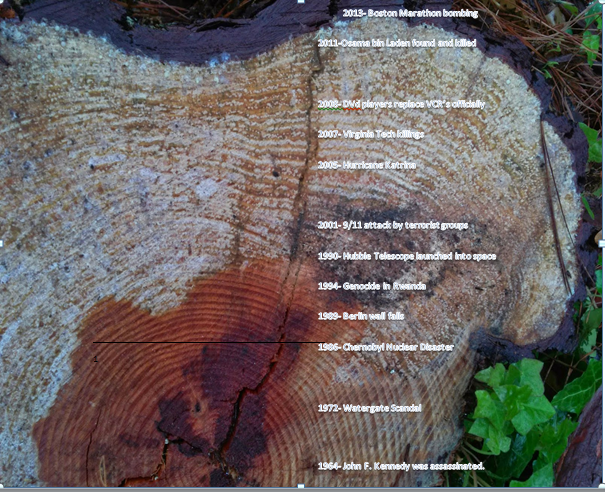The purpose of this lab: was to determine the relative age of a tree by counting the number of tree rings present on the tree.The tree rings represented the xylem of the tree This lab was also done to figure out weather conditions such as rainfall and temperature along with events that would have occurred as the tree grew and the number of tree rings increased. This lab was also a a way to do hindcasting using dendochronology.
 |
Elm Tree Sample from Palm Springs, California, specifically from the San, Hasento Mountain Range, with a desert soil type and a hot, dry climate
By counting the tree rings in the picture, this tree is estimated to be around 30-35 years old. |
 |
Pine tree Sample from Macon, Georgia
By counting the tree rings in the picture, this tree is estimated to be around 50-55 years old.This tree also seems to very healthy as the inner tree rings are darker in color and more defined showing that it survived in pretty favorable weather conditions.
Note:
Based the observations I made by looking at the photos of the tree rings, the tree rings are somewhat uneven and jarred at the edges in both pictures. The reason the outer rings are misshapen is because of how the tree was cut. The blades of the saw during the cutting process were maybe not consistently moved or too unstable to make a clean cut. On further observation of the tree rings, the inner rings seemed to be quite narrower than the outer rings. A reason for this narrowness could be the presence of a drought or another weather event that prevented the tree from getting enough water.
Next, in order to truly understand how the trees lived, the climate conditions and thickness of the tree rings found in Palm Springs and Macon, Georgia have to be examined dating back to 1960's in intervals of 5 years.The rough average temperature of Georgia was about 79 degrees and the average temperature of Pal Springs was about 91 degrees. The average thickness of the tree rings in Georgia ranged from the lowest being 0.13 to the highest at 2.42. The tree ring thickness in Palm Springs was much less varied with the lowest being 0.29 and the highest being 1.17.
Here is a chart for reference:
|
Here is an XY scatter plot to show whether or whether not there is a correlation between tree ring thickness and temperature:
This scatter plot shows that there is a huge difference in temperatures
between the two trees because they are located in two different climate
conditions. However, both trees from the different areas are pretty matched in their tree ring thickness and this shows that temperature did not have a huge effect on the tree rings of these tress. However, it can be noted that in most circumstances, warmer temperatures usually make trees grow better.
Lastly, these two tree samples also represent a much greater idea in terms the environment that the trees lived in. Many major events happened during the growth of these two trees.
Here are two pictures of the tree samples along with major historical events superimposed on them to show that trees can withstand the test of time and live through almost anything including catastrophic events.
To conclude:There is a lot that can be learned from this lab. It is a wonder how tree rings can be such a great indicator of so many things like climate, precipitation and even soil conditions. It is also amazing how tress have such a long lifespan and are not affected very easily because of their strength and resilience.






No comments:
Post a Comment